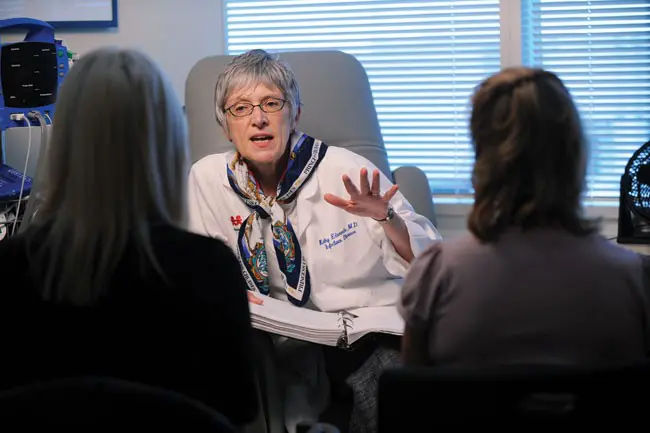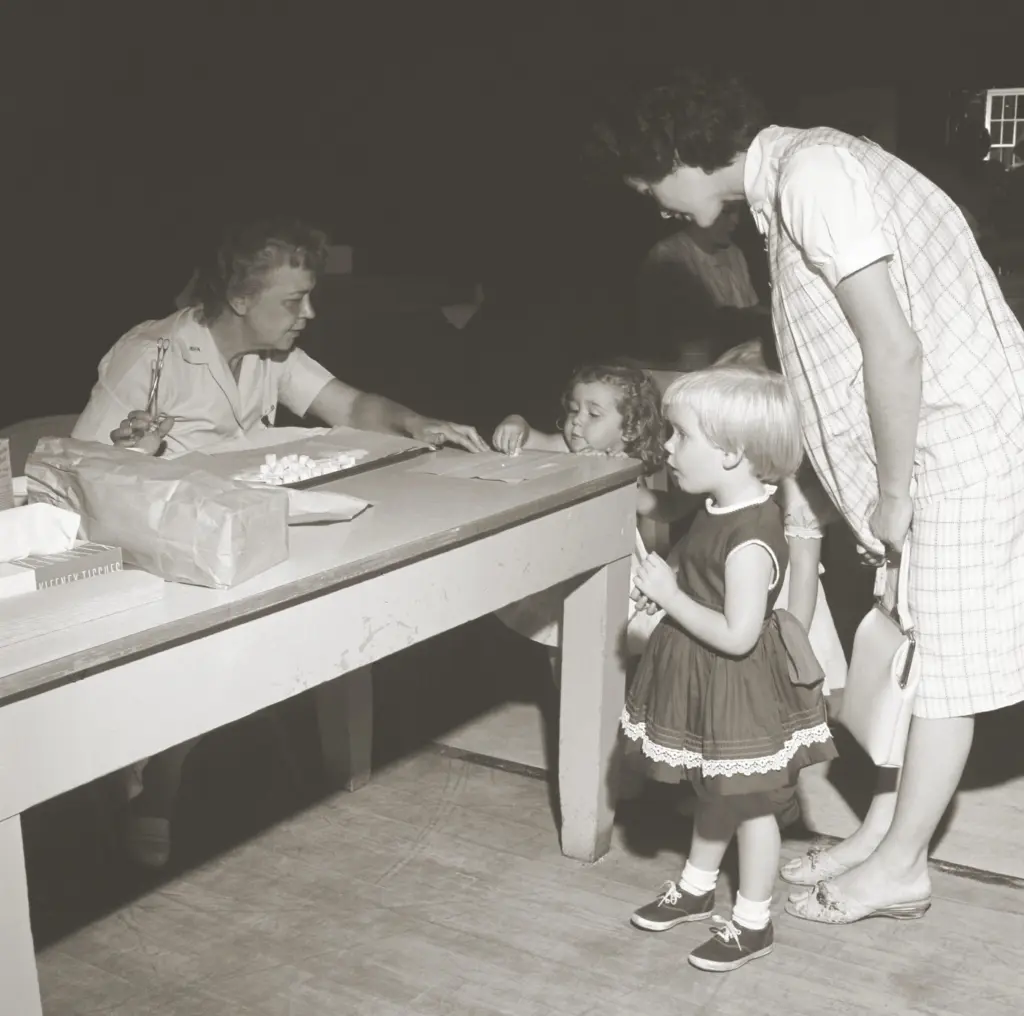
Kathryn Edwards has spent her five-decade career building the science of vaccine safety. Photo courtesy Kathryn Edwards
National Academy of Medicine member Kathryn Edwards turned a defining moment early in her career into a lifelong mission to make vaccines safer for every child.
By Jamie Durana
A toddler arrived at the Chicago hospital on the final night of Kathryn Edwards’ pediatric residency in the summer of 1976. The child was feverish and desperately in need of help. Edwards performed a spinal tap and examined the sample under a microscope. The diagnosis was immediate: Haemophilus influenzae Type B (Hib) Meningitis, a potentially deadly bacterial infection. The hospital typically had three or four such cases at any given moment.
Edwards had finished three years of residency and had dealt with tough cases and critical decisions. “By the time you’re finished with your residency, you think you can take on all the difficult, hard challenges, and you can usually win,” says Edwards. But this child’s infection was too advanced.
There was nothing Edwards could do.
“It was just very, very impactful,” she recalls, because some of the information about how to prevent the disease already existed. At the time, it was known that antibodies against the Hib bacterial capsule could prevent this infection. But a vaccine was not yet available. For Edwards, that was unacceptable.
The experience led Edwards to vaccine research as the focus of her career. Her medical training had given her tools to respond to illness, but what she wanted was to prevent it from happening at all. Her path forward would focus on building evidence, safety protocols, and collaborative partnerships to keep children out of the hospital.
Edwards would spend the next five decades studying vaccines, establishing safety monitoring systems, and working to make sure that the tragedy she witnessed that night in 1976 would become increasingly rare.

Illustration: Talia Lewis
Finding Her Path
Edwards grew up in a small town in Iowa. Education mattered in her household and in her community, which was near the University of Iowa. After high school, Edwards pursued a chemistry degree and changed course to pharmacy school before ultimately switching to medical school where she thrived.
Edwards graduated from the University of Iowa School of Medicine in 1973 and finished her pediatric residency in 1976. Then she pursued two additional years of fellowship training in pediatric infectious diseases and two more years in an immunology research laboratory before she joined Vanderbilt University Medical Center in 1980 to work on vaccine evaluation. The position combined laboratory research, clinical trials, and patient care. “It was like the job had been designed for me,” she says. At the time, diseases like bacterial meningitis and pertussis filled pediatric wards regularly. The need for prevention was clear.
The role at Vanderbilt was a perfect match for Edwards’ combination of experiences—chemistry, pharmacy, medicine—and passion for preventing illness.
Building the Vaccine Safety Field
When Edwards arrived at Vanderbilt in 1980, she joined colleagues who received funding from the National Institutes of Health (NIH) to establish a Vaccine Evaluation Center. They began studying vaccines in collaboration with the local medical community in Nashville, Tennessee. At the time, vaccine trials often were conducted in private pediatric practices. “The pediatricians saw the impact of these bacterial diseases,” Edwards explains. They offered their patients the opportunity to participate in vaccine trials, confident that the vaccines could be safely evaluated.
The vaccines Edwards helped evaluate became licensed and entered routine use, including the Hib meningitis vaccine that might have prevented the death she witnessed in Chicago so many years before. Today, Hib meningitis is so rare Edwards says that most of the current pediatric residents have never seen a case.
Assurance of safety is paramount to ensuring that patients want to take a vaccine, Edwards notes, which is critical in turning the tide on the spread of dangerous infections.
In the early 1990s, concerns about pertussis vaccine side effects swirled. Edwards and Vanderbilt colleagues partnered with the NIH and five other medical centers to test safer formulations. The result was a new generation of pertussis vaccines that maintained effectiveness with fewer reactions.
“We want vaccines that are as safe as possible,” Edwards says. If there are safety questions, it’s important to listen to parents’ concerns and figure out how to make vaccines safer.
The work Edwards and her colleagues started in the 1980s flourished, and in the early 2000s—through a Centers for Disease Control and Prevention (CDC) contract—Vanderbilt established a vaccine safety monitoring and consultation service with several other medical centers for health care providers with questions about vaccine reactions. When COVID-19 arrived, Edwards was on the phone every morning for two years straight, reviewing safety questions with CDC staff and vaccine providers throughout the country.
A Look Inside the Vaccine Safety Apparatus
The vaccine safety monitoring work that intensified during the COVID-19 pandemic had been building since the early 2000s. When health care providers called Vanderbilt’s Vaccine Evaluation Center with concerns (a vaccine was given, a reaction may have occurred, what should we do?), Edwards and her team would mobilize specialists across the medical center.
For example, if a patient developed jaundice or liver dysfunction after receiving a vaccine, hepatologists (liver doctors) were consulted, the medical literature was reviewed for similar cases, CDC records of adverse reactions to vaccines were meticulously searched, and other possible causes of liver injury were investigated. This information was share with the physician who referred the patient and with vaccine experts from the CDC and around the country. These sessions helped assess whether the incident appeared vaccine-related, what additional tests were needed, what follow-up was needed, and whether the vaccine could be safely administered again.
Edwards says the collaborative nature of her work was critical. During the COVID pandemic, when she needed answers from the extraordinarily busy head of the intensive care unit, “I would write an email… and immediately, he would get back [to me]. Everybody wants safe vaccines.”
But the safety infrastructure extends far beyond individual consultations. Edwards has spent much of her retirement serving on Data Safety and Monitoring Committees, independent panels of vaccine experts and immunologists that are funded by pharmaceutical companies but operate with complete autonomy. These committees review adverse events in clinical trials in real time, looking for patterns that might signal problems. If a safety concern becomes apparent, these committees can halt a company’s research, which happened recently when a committee stopped an RSV (respiratory syncytial virus) vaccine study.
During the Pfizer COVID-19 mRNA vaccine trials, Edwards served on such a safety committee. With 30,000 participants in a trial, “there’s a lot of things that are happening,” she notes. The committee met religiously, reviewing every single adverse event.
Weighing Risks and Benefits
Edwards remembers a conversation with a patient’s father on the day the vaccine for the varicella zoster virus (chickenpox) was licensed in 1995. His daughter was in the intensive care unit, about to have her arm amputated. She’d contracted chickenpox, which led to a severe bacterial infection called necrotizing fasciitis. The father looked at Edwards and asked what took so long to make the vaccine available.
For Edwards, the moment captured the tension at the heart of vaccine development. The long process of ensuring vaccine safety before public use “is both a risk and a benefit,” Edwards explains. Delaying a vaccine that could be effective has costs but licensing a potentially unsafe or ineffective vaccine carries its own dangers. “It’s really a rock and a hard place,” says Edwards.
Despite the challenges, Edwards is committed to vaccine safety evaluation. “I became a doctor because I didn’t want kids to be sick,” she says. “Why would I not be concerned if vaccines were in any way contributing to illness and not preventing disease?”

At a 1961 polio vaccination event, sugar cubes containing the oral vaccine are provided to children. Photo: CDC Public Health Image Library
The “Invisible Success” Problem
The success of the vaccines Edwards helped develop—for pertussis, Hib, smallpox, and more—has created an unexpected challenge in a generation of physicians who may never have seen the diseases they prevent.
When Edwards mentions Hib meningitis or polio to residents now, they don’t immediately know what the symptoms look like. These diseases are incredibly rare thanks to widespread vaccination. Vaccines are “like the Maytag repairman,” Edwards says. “We have such a good product that people don’t know the diseases that the vaccines prevent.”
But the consequences of that “invisible success” are already apparent as people become less aware of the threats posed by once-common diseases. Recently, deadly outbreaks of measles have occurred in the United States as vaccination rates have dropped.
Edwards identifies three barriers to vaccine acceptance. First, people don’t see some of the diseases as relevant anymore. She remembers summers growing up when her mother kept her from going swimming because of the threat of polio. Edwards says she was eager to get the sugar cube vaccine at school. Without a visible threat, urgency disappears.
Second, many people are afraid that the vaccines are not safe and are unaware of the vaccine development process and its layers of scrutiny and oversight. Researchers spend years testing potential vaccines in the laboratory to find a safe, effective formulation, then three escalating phases of human trials follow. Small groups to refine the dose, larger groups to ensure safety, and massive trials involving tens of thousands of vaccine recipients to confirm the vaccine truly prevents disease. By the time a vaccine reaches the public, it has already cleared an extraordinary series of independent reviews and safety checks.
Third, there’s resistance to being “told what to do,” or “mandated” to receive certain vaccines, even in the interest of community protection, a concept that has become increasingly important as the number of children who cannot safely receive certain vaccines has grown dramatically, including bone marrow transplant recipients, cancer patients, children with immune deficiencies, and heart transplant recipients. These vulnerable populations depend on community-wide immunity to slow or prevent transmission of infectious diseases.
The Ultimate Goal: Prevention Over Treatment
Even in her retirement, Edwards’ commitment to preventing disease drives her. She remains active in vaccine safety work, serving on multiple Data Safety and Monitoring Committees. The infrastructure she helped build—the surveillance systems, the safety protocols, the collaborative networks—continues through the scientists Edwards has mentored, many of whom now run the surveillance and safety programs she helped establish.
She thinks often about what’s at stake. “Prevention of disease is just so much more effective than having to treat when kids are sick,” she says. “Vaccines have had an enormous impact on the global burden of disease.”
The contrast with that June night in 1976 is stark. Back then, Edwards could only watch as a child died from a devastating infection that can now be prevented. In the decades since, she has helped build the tools to prevent deadly infections and the systems to ensure they are safe. Across 50 years of patient care, research, and vaccine safety oversight, her purpose has remained the same: to stop children from arriving at the hospital in the first place.

